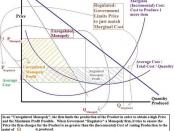Economics defines a monopoly as being a "persistent market situation where there is only one provider of a kind of product or service (good)." There are certain factors that make monopolies unlike any other market situation. There are actual three of these factors: competition, substitutes, and entry into the monopolized market. There are also many different types or forms of monopolies. The main five types are: legal, natural, local, competitive, and coercive. A popular way to understand monopolies and all that they entangle is with an economic analysis. Where primary characteristics of monopolies are examined, as well as monopolistic pricing, which then leads to being able to calculate a monopoly's output. Finally we will see some historical examples such as salt!
"Monopolies are often distinguished based on the circumstances under which they arise; the main distinctions are between a monopoly that is the result of law (government-granted monopoly, and government monopoly) alone; one that arises from the cost structure of the industry (natural monopoly); and one that arise by other means (e.g.
one firm simply outcompeting all other firms; illegal behavior; etc). Advocates of economic liberism assert that a more fundamental way of classifying monopolies is to distinguish those that arise and exist due to violation of the principles of a free market (Coercive monopoly) from those that arise and are maintained by consistently outcompeting all other firms."
A legal monopoly is managed by the government in forms of laws, these laws are placed explicitly for the purpose of preventing competition. It is also known as a government-granted monopoly. When it is operated by the government itself then the monopoly is know as a government monopoly, or a state monopoly, obviously. But there is a difference between these two. A government monopoly is limited, or better...


